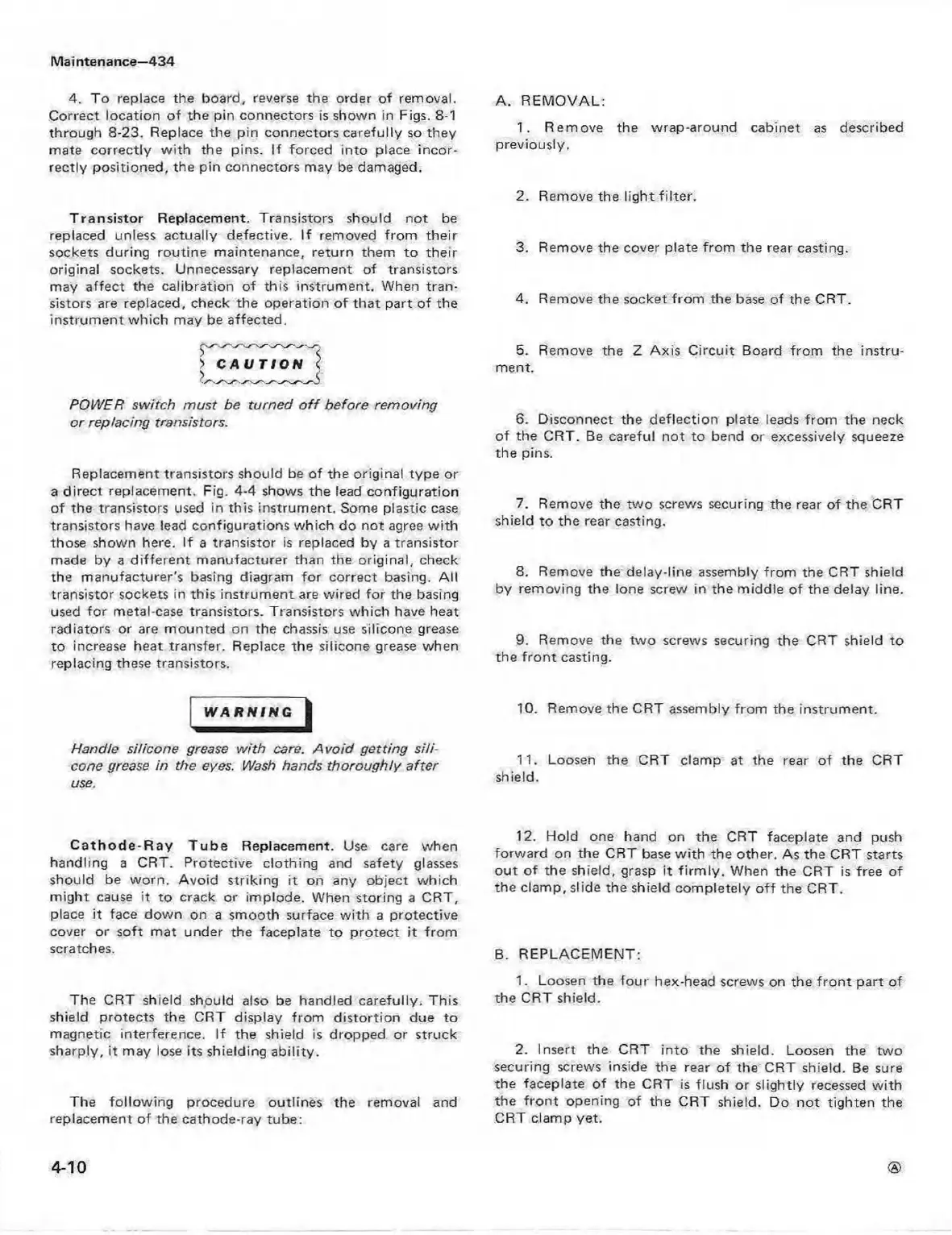Ma i nten ance—434
4. To replace the board, reverse the order of removal.
Correct location o f the pin connectors is shown in Figs. 8-1
through 8-23. Replace the pin connectors carefully so they
mate correctly w ith the pins. If forced into place incor
rectly positioned, the pin connectors may be damaged.
T ran sistor Replacement. Transistors should not be
replaced unless actually defective. If removed from their
sockets during routine maintenance, return them to their
original sockets. Unnecessary replacement of transistors
may affect the calibration of this instrument. When tra n
sistors are replaced, check the operation o f tha t part of the
instrum ent which may be affected.
POWER switch m ust be turned o ff before rem oving
or replacing transistors.
Replacement transistors should be of the original type or
a direct replacement. Fig. 4-4 shows the lead configuration
of the transistors used in this instrum ent. Some plastic case
transistors have lead configurations which do not agree w ith
those shown here. If a transistor is replaced by a transistor
made by a differe nt m anufacturer than the original, check
the manufacturer's basing diagram for correct basing. A ll
transistor sockets in this instrum ent are wired fo r the basing
used fo r metal-case transistors. Transistors which have heat
radiators or are mounted on the chassis use silicone grease
to increase heat transfer. Replace the silicone grease when
replacing these transistors.
WARNING
Handle silicone grease w ith care. A vo id getting s ili
cone grease in the eyes. Wash hands thoroughly after
use.
Cathode-Ray Tube Replacement. Use care when
handling a CRT. Protective clothing and safety glasses
should be worn. A void striking it on any object which
m ight cause it to crack or implode. When storing a CRT,
place it face down on a smooth surface w ith a protective
cover or soft mat under the faceplate to protect it from
scratches.
The CRT shield shpuld also be handled carefully. This
shield protects the CRT display from distortion due to
magnetic interference. If the shield is dropped or struck
sharply, it may lose its shielding ab ility.
The follow ing procedure outlines the removal and
replacement of the cathode-ray tube:
A. R E M O VAL:
1. Rem ove the wrap-around cabinet as described
previously.
2. Remove the light filte r.
3. Remove the cover plate from the rear casting.
4. Remove the socket from the base of the CRT.
5. Remove the 2 Axis Circuit Board from the instru
ment.
6. Disconnect the deflection plate leads from the neck
o f the CRT. Be careful not to bend or excessively squeeze
the pins.
7. Remove the tw o screws securing the rear o f the CRT
shield to the rear casting.
8. Remove the delay-line assembly from the CRT shield
by removing the lone screw in the middle of the delay line.
9. Remove the tw o screws securing the CRT shield to
the fro n t casting.
10. Remove the CRT assembly from the instrum ent.
11. Loosen the CRT clamp at the rear o f the CRT
shield.
12. Hold one hand on the CRT faceplate and push
forward on the CRT base w ith the other. As the CRT starts
out o f the shield, grasp it firm ly . When the CRT is free of
the clamp, slide the shield completely o ff the CRT.
B. REPLACEM ENT:
1. Loosen the fou r hex-head screws on the fro n t part of
the CRT shield.
2. Insert the CRT into the shield. Loosen the tw o
securing screws inside the rear of the CRT shield. Be sure
the faceplate of the CRT is flush or slightly recessed w ith
the fro n t opening of the CRT shield. Do no t tighten the
CRT clamp yet.
4-10

